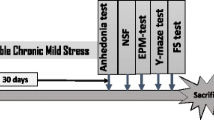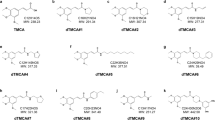Abstract
This study investigated the effects of (−)-sesamin on chronic electric footshock (EF) stress-induced anxiety disorders in mice. Mice were treated with (−)-sesamin (25 and 50 mg/kg) orally once a day for 21 days prior to exposure to EF stress (0.6 mA, 1 s every 5 s, 3 min). Mice treated with (−)-sesamin (25 and 50 mg/kg) exhibited less severe decreases in the number of open arm entries and time spent on open arms in the elevated plus-maze test and the distance traveled in the open field test following exposure to chronic EF stress. Similarly, mice treated with (−)-sesamin exhibited significantly less severe decreases in brain levels of dopamine, norepinephrine, and serotonin following exposure to chronic EF stress. Increases in serum levels of corticosterone and expression of c-Fos were also less pronounced in mice treated with (−)-sesamin (25 and 50 mg/kg). These results suggest that (−)-sesamin may protect against the effects of chronic EF stress-induced anxiety disorders by modulating dopamine, norepinephrine, and serotonin levels, c-Fos expression, and corticosterone levels.





Similar content being viewed by others
References
Rajkowska G (2000) Postmortem studies in mood disorders indicate altered numbers of neurons and glial cells. Biol Psychiatry 48:766–777
Zhao TT, Shin KS, Choi HS, Lee MK (2015) Ameliorating effects of gypenosides on chronic stress-induced anxiety disorders in mice. BMC Complem Altern Med 15(323):1–10
Sheikh N, Ahm A, Siripurapu KB, Kuchibhotla VK, Singh S, Pali G (2007) Effect of Bacopa monniera on stress induced changes in plasma corticosterone and brain monoamines in rats. J Ethnopharmacol 111:671–676
Sheline YI (2000) 3D MRI studies of neuroanatomic changes in unipolar major depression: the role of stress and medical comorbidity. Biol Psychiatry 48:791–800
Chen X, Herbert J (1995) Regional changes in c-fos expression in the basal forebrain and brainstem during adaptation to repeated stress: correlations with cardiovascular, hypothermic and endocrine. Neuroscience 64:675–685
Imaki T, Katsumata H, Konishi SI, Kasagi Y, Minami S (2003) Corticotropin-releasing factor type-1 receptor mRNA is not induced in mouse hypothalamus by either stress or osmotic stimulation. J Neuroendocrinol 15:916–924
Russell JA, Shipston MJ (2015) Neuroendocrinology of stress. In: Hale MW, Lowry CA (eds) Brain m onoaminergic s ystems in s tress n euroendocrinology, Chap. 2. Wiley, New York, pp 19–42
Broderick PA, Phelix CF (1997) Serotonin (5-HT) within dopamine reward circuits signals open-field behavior. II. Basis f or 5-HT-DA interaction in cocaine dysfunctional behavior. Neurosci Biobehav Rev 21:227–260
Espejo EF (1997) Selective dopamine depletion within the medial prefrontal cortex induces anxiogenic-like effects in rats placed on the elevated plus maze. Brain Res 762:281–284
G riebel G, R odgers RJ, Perrault G, S anger DJ (1997) Risk assessment behaviour: evaluation of utility in the study of 5-HT-related drugs in the rate levated plus-maze test. Pharmacol Biochem Behav 57:817–827
Han AR, Kim HJ, Shin M, Hong M, Kim YE, Bae H (2008) Constituents of Asarum sieboldii with inhibitory activity on lipopolysaccharide (LPS)-induced NO production in BV-2 microglial cells. Chem Biodivers 5:346–351
Peñalvo JL, Hopia A, Adlercreutz H (2006) Effect of sesamin on serum cholesterol and triglycerides levels in LDL receptor-deficient mice. Eur J Nutr 45:439–444
Suzuki Y, Yuzurihara M, Hibino T, Yano S, Kase Y (2009) Aqueous extract of Asiasari Radix inhibits formalin-induced hyperalgesia via NMDA receptors. J Ethnopharmacol 123:128–133
Han Y, Kim SJ (2003) Memory enhancing actions of Asiasari Radix extracts via activation of insulin receptor and extracellular signal regulated kinase (ERK) I/II in rat hippocampus. Brain Res 974:193–201
Park HJ, Zhao TT, Lee KS, Lee SH, Shin KS, Park KH et al (2015) Effects of (−)-sesamin on 6-hydroxydopamine-induced neurotoxicity in PC12 cells and dopaminergic neuronal cells of Parkinson’s disease rat models. Neurochem Int 83–84:19–27
Guo HL, Xiao Y, Tian Z, Li XB, Wang DS, Wang XS, Zhang ZW, Zhao MG, Liu SB (2016) Anxiolytic effects of sesamin in mice with chronic inflammatory pain. Nutr Neurosci 19:231–236
Kumar B, Kuhad A, Chopra K (2011) Neuropsychopharmacological effect of sesamol in unpredictable chronic mild stress model of depression: behavioral and biochemical evidences. Psychopharmacology (Berl) 214:819–828
Li CY, Chow TJ, Wu TS (2005) The epimerization of sesamin and asarinin. J Nat Prod 68:1622–1624
Choi HS, Zhao TT, Shin KS, Kim SH, Hwang BY, Lee CK (2013) Anxiolytic effects of herbal ethanol extract from Gynostemma pentaphyllum after exposure to chronic stress in mice. Molecules 18:4342–4356
Zhao TT, Shin KS, Kim KS, Park HJ, Kim HJ, Lee KE, Lee MK (2016) Effects of (−)-sesamin on motor and memory deficits in an MPTP-lesioned mouse model of Parkinson’ s disease treated with L-DOPA. Neuroscience 339:644–654
Lister RG (1987) The use of a plus-maze to measure anxiety in the mouse. Psychopharmacology (Berl) 92:180–185
Verma P, Hellemans KGC, Choi FY, Yu W, Weinberg J (2010) Circadian phase and sex effects on depressive/anxiety-like behaviors and HPA axis responses to acute stress. Physiol Behav 99:276–285
Vallone D, Picetti R, Borrelli E (2000) Structure and function of dopamine receptors. Neurosci Biobehav Rev 24:125–132
Zhao TT, Shin KS, Choi HS, Lee MK (2013) Effects of gypenosides on acute stress in mice. Nat Prod Sci 19:337–341
Rodgers RJ, Haller J, Holmes A, Halasz J, Walton TJ, Brain PF (1999) Corticosterone response to the plus-maze: high correlation with risk assessment in rats and mice. Physiol Behav 68:47–53
Skórzewska A, Lehner M, Wisłowska-Stanek A, Krząścik P, Ziemba A, Płaźnik A (2014) The effect of chronic administration of corticosterone on anxiety- and depression-like behavior and the expression of GABA-A receptor alpha-2 subunits in brain structures of low- and high-anxiety rats. Horm Behav 65:6–13
Shi SN, Shi JL, Liu Y, Wang YL, Wang CG, Hou WH, Guo JY (2014) The anxiolytic effects of valtrate in rats involves changes of corticosterone levels. Evid-Based Compl Alt 325948:1–8
Smith SM, Vale WW (2006) The role of the hypothalamic–pituitary–adrenal axis in neuroendocrine responses to stress. Dialogues Clin Neurosci 8:383–395
Ohshima H, Bartsch H (1994) Chronic infections and inflammatory processes as cancer risk factors: possible role of nitric oxide in carcinogenesis. Mutat Res 305:253–264
Hou RCW, Huang HM, Tzen JTC, Jeng KCG (2003) Protective effects of sesamin and sesamolin on hypoxic neuronal and PC12 cells. J Neurosci Res 74:123–133
Hamada N, Fujita Y, Tanaka A, Naoi M, Nozawa Y, Ono Y et al (2009) Metabolites of sesamin, a major lignan in sesame seeds, induce neuronal differentiation in PC12 cells through activation of ERK1/2 signaling pathway. J Neural Transm 116:841–852
Kuo PC, Lin MC, Chen GF, Yiu TJ, Tzen JTC (2011) Identification of methanol-soluble compounds in sesame and evaluation of antioxidant potential of its lignans. J Agric Food Chem 59:3214–3219
Acknowledgements
This research was financially supported by the National Research Foundation of Korea (Grant No. 2013R1A1A2058230, 2015–2016), Republic of Korea.
Author information
Authors and Affiliations
Corresponding author
Ethics declarations
Conflict of interest
There are no conflict of interest.
Rights and permissions
About this article
Cite this article
Zhao, T.T., Shin, K.S., Park, H.J. et al. Effects of (−)-Sesamin on Chronic Stress-Induced Anxiety Disorders in Mice. Neurochem Res 42, 1123–1129 (2017). https://doi.org/10.1007/s11064-016-2146-z
Received:
Revised:
Accepted:
Published:
Issue Date:
DOI: https://doi.org/10.1007/s11064-016-2146-z




